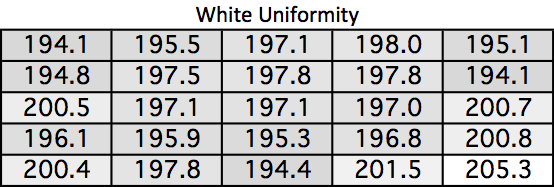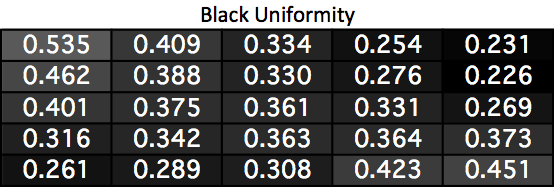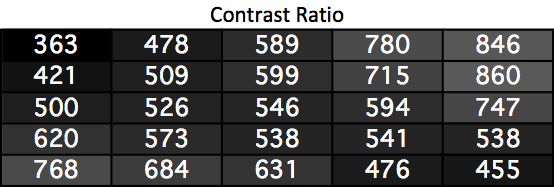NEC PA242W Monitor Review
by Chris Heinonen on September 27, 2013 9:00 AM ESTWith the switch to CalMAN we have been able to use much better methods for measuring display uniformity. Instead of getting unique dE2000 values for each point on the screen, they are compared to the center of the screen to give us a true uniformity value. We also measure 24 patches so we have a much more accurate idea of overall color and brightness uniformity than just measuring white level. Now with the test data from the NEC PA242W, I can finally use it to show why a professional monitor costs so much more.


Look at the white uniformity data. I usually am very happy if nothing varies from the center by more than 10%. On the NEC PA242W the maximum variation is 4.2%. A white field on the screen is white, and it is the same level everywhere. No monitor before has come close to this performance, which is a testament to the design of the NEC backlight setup.


Black uniformity is not nearly as good as white. Two corners are much darker and two are much lighter than the center. I’m surprised by this as good uniformity usually works both ways, but it seems that white uniformity is being judged to be more important overall than black uniformity here.


Since the white uniformity was almost perfect, this is just a mirror of the black uniformity chart. Two corners have much higher contrast ratios and two are much worse. It’s a bit disappointing just like the black uniformity is.

The color error uniformity is not disappointing at all. Instead, it is practically perfect. No area of the screen has an average dE2000 error >1 compared to the center. Since an error less than 1 is invisible to the eye, even on still images, this really is perfect. Even if the numbers were lower you wouldn’t see a difference, so I will just say this is perfect.
Uniformity like this has not been seen in my testing before. This performance is what professional designers and photo editors’ need, and it is what NEC delivers. It is expensive, but for many people it is worth paying for as it has untouched uniformity performance.










74 Comments
View All Comments
cheinonen - Monday, September 30, 2013 - link
The current version of CalMAN, at least one of the higher end versions, has support for calibrating a set of displays to look identical. It might mean none of them are perfect, but they all look about the same. I've never tested it out, as it's meant for commercial installations, but that might help with this issue if you already have the monitors.1Angelreloaded - Saturday, October 5, 2013 - link
instead of using 3 monitors, have you ever thought about moving to a large format display they make professional based ones for 40inch and higher now at 4k levels with IPS tech, that's a lot more realestate than say 3 1080p s side by side.nathanddrews - Friday, September 27, 2013 - link
I think I already know the answer to this: "too much".How much would it actually add to the cost of a monitor to have it pre-calibrated using this method at the factory? Obviously a trained human would be expensive and time consuming, but what about a series of sensors on the assembly line that tune the display before packaging? Panels that meet the requirements for uniformity and gamut get one price, displays that can't make the cut go off to a different bin. Doesn't seem too ridiculous to me.
Senti - Friday, September 27, 2013 - link
The problem is the transportation after that will likely screw everything in unpredictable way.nathanddrews - Friday, September 27, 2013 - link
How, exactly? I've never heard of shipping or transporting affecting display calibration...foxalopex - Friday, September 27, 2013 - link
Professional calibration software like Spectraview is designed to ask for a recalibration every 2-4 weeks. So yes by the time it gets to you it's not as calibrated as it could be. Keep in mind this is a professional monitor so they're nothing like a normal user. If you're more on a budget, a good $600-700 IPS monitor would probably work for most folks but for folks who insist on the best, you can't go wrong.DanNeely - Friday, September 27, 2013 - link
That drift is due to components aging with; a good factory calibration should still be good when you unbox it and will stay better than what we normally suffer with for a while since the bad one is drifting too.Some tablet vendors have been doing it for at least a year now. I'd be interested in seeing how much the screens on them have drifted if Anandtech used any of the tablets they did color calibration testing a year ago as daily drivers.
bobbozzo - Friday, September 27, 2013 - link
see above:cheinonen - Friday, September 27, 2013
...the out-of-box experience is also very good and it is still more uniform than any other display tested to date. The calibration does not affect the uniformity.
cheinonen - Saturday, September 28, 2013 - link
Just as an FYI, measuring the uniformity to the degree that I do takes close to two hours per display. That's with a fast meter and moving it between locations as quickly as possible but still allowing time for each sample to settle and be accurate. Adding that kind of testing to every display will increase the price a lot. Most companies wouldn't see any return on investment there, since the majority of consumers still don't care enough. Even if you only add $25 to the cost, that's a lot for most people unless you're talking about $1,200 displays.dushyanth - Friday, September 27, 2013 - link
which would you choose: Eizo CS230 or this